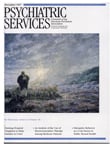A Comparison of Psychotic and Nonpsychotic Substance Users in the Psychiatric Emergency Room
Abstract
Current illicit drug and alcohol users were identified by laboratory evaluation of urine samples from nonpsychotic patients without a primary clinical diagnosis of a substance use disorder seen in a psychiatric emergency room. Urine screens revealed that 32 of 93 nonpsychotic patients (34 percent) had used a substance just before visiting the emergency room. Compared with nonusers, users were more often Caucasian females with adjustment disorders who admitted their previous substance use. The prevalence of concurrent use among nonpsychotic patients was higher than among psychotic patients. Nonpsychotic and psychotic users differed in gender, marital status, level of suicidality, self-report of use, the clinician's suspicion of use, use of seclusion during the visit, admitting status, level of care, and disposition.



